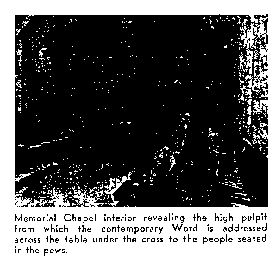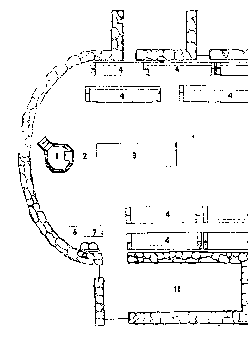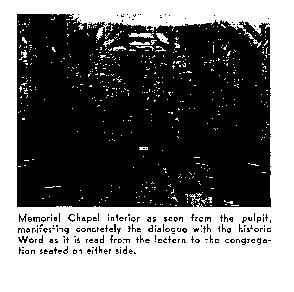
 |
From the beginning of the Christian community, the people know n as Christians have gathered in order to hold up before themselves the symbol by which they have lived and without which they would be unable to maintain themselves in their mission in and to the world of their day. The early Christians, particularly after they encountered violent persecution by the Roman Empire, gathered for this office in the homes of wealthy Roman members as well as more privately in the several dwelling places of the members scattered in the various cities.
Early the large Roman home became the principal place of the weekly meeting. In its halls gradually the Christian material symbols, .such as any community develops as indicative of their particular calling, began to take the place of the Roman deities and the family heirlooms. Such locations within the house as the symbolic seat of the head of the family and the central pool which hearkened back as far as very primitive Roman times, assumed the role of symbols for the Christian gathering. Thus, the meeting place of the Church came to have meaning in and of itself, quite apart from the daily use to which it was put by those living in the house.
From that time the Church has continued to set aside particular places for the worship of the One which they know as Lord, and has appointed these places with the symbolic objects of the Community. These objects, such as the cross, the table, the pulpit, the lectern, and the pews, point to the reality before which the Church lives and in which it participates. It would not be possible for the Church to be the Church apart from them, any more than it would be possible for the United States of America to be the United States of America apart from the Stars and Stripes and the history which is a part of that flag.
What is true for the Church in its universal scope is true of any particular congregation of the Church. Each congregation develops its own adaptations of these symbols for their own use and their own day. But they can never dispense with them; they are the life image of the Church.
It is not surprising, then, that the Christian Faith-and-Life Community has set aside a space for the celebration of the corporate symbolic activity which is Christian worship, and that this space should participate actively in the ancient Christian material symbols. The Memorial Chapel, set within the compound of the Community's College House, has taken its particular form and internal arrangement as a result of the Community's continual dialogue with the history of the Church and the culture of the 20th century.
In the Chapel, a small stone building with a rough brick floor and a rustic wood-beamed ceiling, gather twice daily participants in the program of the Community. The Daily Office of the Christian Faith-and-Life Community forms the basis for the daily worship of the Community's staff and families each week-day morning at seven o'clock, and for the evening
 |
 |
|
|
worship of the College House at five-fifteen, Monday through Friday.
Here the earthy lofty activity of the Church is dramatized through the intimate participation of each one gathered. The pews, arranged so that the congregation is divided into two parts, each one facing squarely the other, form what in a Gothic cathedral would be the choir, the location for the active participants in the service. A glance at the accompanying chart will reveal that the people sit, stand, and kneel in the center of the great stage about the table of the Lord, Ranked on either side by the pulpit, the symbol of the contemporary spoken Word in Jesus Christ, and the lectern, the symbol of the Word addressed to our day from the history of the Christian community. High above the assembled people hangs a heavy wooden cross from a sturdy iron chain, which brings the symbolic gathering into focus. Thus it is that a double dialogue is carried on. It crackles between the pulpit and the lectern as the historic Word becomes contemporary, and between the two sides of the congregation as they face one another about the table in the sign of the cross.
Picture the beginning of the morning service. The Community is gathered. The bell at the Chapel entrance is rung three times and immediately the reader of the scripture enters bearing the large lectern Bible. The people rise and follow the reader and his burden with their eyes. No sooner is the book opened on its stand than the remaining three liturgists enter and assume their places at the reading desks on either end of the North pews. The Community kneels in prayer, then rises "In the Name of the Father, and the Son, and the Holy Ghost." Sent to its knees in confession, the Community is lead in the acknowledgment of their estranged relation with God, others, and themselves. Then, upon hearing the Word that they are free to live as the people they are, the congregation breaks forth in one of the great Hebrew psalms and into the historic Christian refrain, "Glory be to the Father. . ."
You next see these gathered people listening intently to the reading from the scripture and then to the declaration of the testimony of one of their number concerning the possibility of life in faith. These battle cries drive the people once more to their knees, soberly to assume their role as people responsible for the entire world through the symbol of intercessory prayer. But once on their knees, the awareness comes that it is on their feet and in the world that the job is to he done. They swiftly rise to present the money offering as token of their assumed responsibility, to pass the Peace of God to one another, to receive the benediction, and to go with courage into the life that is their life that day.
A mighty symphony played by the liturgy. the people. and the Chapel has gone on for these brief moments, and once again the building stands silent, a mute yet vibrant witness in our midst that we have no excuse for refusing to live fully our lives and die gladly our deaths before the One who is Lord of all the limits of life.
 |
 |